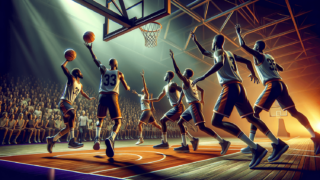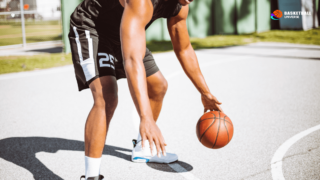
Why Do Basketball Players Wipe Their Shoes?
Written by: Basketball Universe
Last updated:

For those who marvel at the exquisite dance of athletes on the basketball court, the sight of players wiping their shoes might seem puzzling at first. But fear not, court-side enthusiasts! In this fun and insightful blog post, we are going to explore the fascinating world of shoe wiping and its crucial impact on every player’s performance. Join us as we delve into the reasons behind this common practice, and how, far from being a mere superstition, it plays a vital role in the nail-biting dynamics of the game. So, fasten your high-tops and let’s uncover the secret of the swipes!
Why Do Basketball Players Wipe Their Shoes?
Basketball players wipe their shoes to maintain optimal traction on the court. This action removes the dust, dirt, and sweat that accumulate on the shoe soles, ensuring a better grip during swift movements, sudden stops, and quick turns. Adequate traction prevents players from slipping, which could lead to injuries or a decrease in performance. Overall, shoe wiping is an essential practice that contributes to a safe and smooth gameplay experience for basketball athletes.
Traction: The Name of the Game in Basketball
When it comes to basketball, one factor reigns supreme: traction. The ability to move swiftly, change directions on a dime, and maintain control of the game lies in the grip between the player’s shoes and the court surface. Basketball players possess a keen awareness of the subtle nuances that separate wins from losses, so keeping their soles clean becomes a top priority during a match. This pursuit of optimal traction kicks off our fascinating exploration of the practice of wiping one’s shoes on the court.
The Impact of Dust and Debris on Performance
The basketball court is a battleground where players must contend not only with their opponents, but also with the invisible enemy of dust and debris. Even the cleanest-looking courts often harbor a fine layer of dust, which can attach itself to the shoe soles and wreak havoc on traction.
Reduced Shoe Grip
Dust and debris lodged on the shoe soles can much reduce grip, leading to slips or slides when players execute rapid movements or sharp turns. Instead of moving with precision, the player ends up adjusting for the lack of grip during gameplay, risking injuries and missed scoring opportunities.
Increased Risk of Injuries
As mentioned earlier, the danger of slipping on the court cannot be understated. Basketball is a high-intensity game, and slips or sudden loss of balance can result in injuries such as sprained ankles, dislocated knees, or even broken bones. Many basketball players have suffered season-ending injuries due to poor traction on the court, underlining the importance of shoe wiping.
Performance Inconsistency
Dust and debris can lead to performance inconsistency due to varying amounts of grip throughout the game. Players may find difficulty in maintaining a predictable level of traction for effective ball-handling and shooting, resulting in missed opportunities and reduced team synergy.
A Look at Shoe Soles: Materials and Design
Understanding why basketball players wipe their shoes mandates delving into the world of shoe design and materials. The ideal basketball shoe offers a blend of grip, cushioning, and support, allowing athletes to perform at their absolute best while minimizing the risk of injury.
Rubber Compounds and Patterns
The rubber composition and pattern featured on the sole of most basketball shoes are crucial factors in delivering optimal traction. However, not all rubbers and patterns are created equal. Some soles utilize soft, sticky rubber that provides a high level of grip but wears down quickly. Others use harder rubber compounds that last longer but sacrifice some grip. When dust and debris interfere with the intended design of the rubber sole, players must swiftly restore a proper grip on the court.
Outsole Flexibility
A flexible outsole allows the shoe to move naturally with the foot while maintaining a robust grip on the court. Shoe wiping can help enhance the outsole’s flexibility since a clean, dust-free surface ensures maximum contact and indentation into the hardwood.
Methods and Tools for Wiping Shoes
From pre-game techniques to mid-game tactics, basketball players apply various methods and tools to maintain their shoes’ optimal traction. Let’s explore these approaches in assisting athletes to stay at the top of their game.
Hand Wipes
The most common and immediate method that players employ during a game is wiping their shoes with their hands. This quick-fix approach is effective for removing dust and moisture, but it can also introduce sweat onto the shoe surface, potentially compromising grip.
Wet Towel
Some players prefer using a towel dipped in water to ensure the most thorough cleaning. Wetting a towel and rubbing it on the shoe soles can remove stubborn dust and dirt particles. This method, predominantly used during timeouts or breaks, is highly efficient but not always practical during the heat of the game.
Sticky Pads
Sticky pads, also known as traction boards or grip mops, are increasingly popular among basketball players. These pads contain an adhesive surface that effectively removes dust and dirt from shoe soles when stepped upon. Teams often place sticky pads near the bench or the edge of the court for quick access during breaks or in-between plays.
Traction Enhancing Sprays and Products
Besides shoe wiping, players may opt for traction-enhancing sprays or liquids designed to improve shoe grip on the court. These products, usually applied before gameplay, claim to provide maximum traction for extended periods. That said, their efficacy varies and may not be universally beneficial for all court conditions or shoe types.
Preventing and Minimizing the Shoe Wiping Dilemma
While it’s impossible to play on a perpetually clean court, certain measures can help reduce the frequency and necessity of shoe wiping during the game. These preventative tips aim to keep the playing surface and players’ shoes as dust-free as possible.
Regular Court Cleaning
Keeping the court clean by sweeping or mopping on a consistent basis and in-between games will minimize the accumulation of dust and debris, reducing the need for players to wipe their shoes frequently.
Shoe Rotation and Care
A regular rotation and proper care of footwear can make a significant difference in shoe performance. Participating in multiple sports or activities with the same pair of shoes increases the chances of picking up dirt or grime, compromising grip on the basketball court. Players should use separate pairs of shoes for indoor courts and outdoor courts, while regularly cleaning and checking the soles for wear and tear.
Appropriate Shoe Selection
Selecting the right shoe for a specific court surface can help mitigate the constant need for wiping. Some shoe models may perform better on specific surfaces than others, making it crucial for players to research and choose footwear that best suits their needs and preferences.
The Psychological Aspect of Shoe Wiping
While maintaining traction is the primary reason behind shoe wiping, the ritual also serves a psychological purpose for many athletes. The act of wiping one’s shoes can be a grounding technique that resets the mind and prepares the player for their next move, creating a sense of mental readiness and focus.
Routine and Superstition
Basketball players often have routines and superstitions that they believe either enhance performance or provide good luck. For some athletes, shoe wiping can be one of those rituals that helps them feel confident on the court.
Body Language and Signaling
Interestingly, shoe wiping can sometimes act as a body language signal between players or as a simple form of communication. This could mean anything from intending to play-off an opponent or attempting a steal, to signaling a change in strategy to their teammates.
Conclusion
It’s clear that the act of wiping one’s shoes on the basketball court is about much more than what meets the eye. Maintaining reliable traction plays a critical role in player performance, injury prevention, and overall game integrity. By understanding the reasons behind shoe wiping and exploring the ways to minimize dust and debris on the court, athletes can ensure a safer, more enjoyable basketball experience for all involved.
Choosing the Right Gear: Shoe Maintenance and Replacement
When it comes to ensuring the best performance on the basketball court, players not only need to keep their shoes clean but also need to consider the overall condition of their footwear. Good shoe maintenance, combined with understanding when to replace them, can help prevent common issues associated with worn-out shoes and keep the focus on the game itself.
Inspecting Shoe Soles and Cushioning
Regularly inspecting shoe soles for signs of wear is essential for maintaining proper traction on the court. If the rubber sole’s pattern or grooves appear worn or flattened, it may be time to consider replacing the shoes. Additionally, players should evaluate the cushioning and support structures inside the shoe, as these also contribute to optimal performance and injury prevention.
Investing in High-Traction Shoe Models
Several basketball shoe manufacturers have developed models specifically designed to provide exceptional traction on the court. Researching and investing in these high-traction models can help reduce the need to wipe shoes repeatedly, keeping athletes’ minds focused on the game. Some popular shoe models that prioritize traction include:
- Nike Kyrie Series
- Adidas Harden Series
- Under Armour Curry Series
Though investing in these high-traction shoes can help, even the best shoe models require occasional wiping to maintain optimal grip on the court.
The Science Behind Traction Technology
From innovative sole design to traction-enhancing products, modern technology offers a helping hand in the quest to achieve and maintain the best possible grip during gameplay. Let’s take a closer look at some advances in traction technology that can benefit basketball players.
Multidirectional Traction Patterns
Shoe manufacturers are continually experimenting with and refining traction patterns on their basketball models. These multidirectional patterns allow for increased grip during diverse movements, such as quick pivots, lateral cuts, and sudden stops. Examples of famous traction patterns include herringbone, spiral, and storytelling designs, each providing unique benefits tailored to specific gameplay requirements.
Non-marking Outsoles
Non-marking outsoles are frequently found on indoor basketball shoes, designed to ensure firm grip without leaving unsightly scuff marks on the court. These shoes offer the perfect balance of grip, durability, and aesthetics, making them a popular choice among athletes.
Nanotechnology-enhanced Rubber Compounds
One exciting development in shoe manufacturing comes from the integration of nanotechnology into the rubber compounds used to create shoe soles. This technological breakthrough allows for enhanced grip without compromising durability, placing it at the forefront of traction-enhancing innovations.
Understanding Court Conditions and Adaptation
Each basketball court comes with its unique set of conditions that can influence traction levels. Players must adapt to these different conditions to perform consistently and avoid unnecessary wiping during gameplay.
Indoor vs. Outdoor Courts
Indoor and outdoor basketball courts differ in terms of surface material, texture, and cleanliness. Indoor courts are typically made of hardwood or synthetic materials, while outdoor courts feature concrete or asphalt surfaces. Understanding the differences and adapting one’s shoe-wiping habits accordingly will help ensure a better grip on the court and reduce the need to wipe shoes frequently.
Climate and Humidity
Climate and humidity levels in the playing environment can significantly impact traction on the court. High humidity levels can cause moisture buildup on the court surface, leading to reduced grip and increased shoe-wiping requirements. Similarly, cold weather can cause rubber soles to harden, resulting in diminished traction. By taking such climate-related factors into account, players can better gauge and optimize their shoe-wiping habits during gameplay.
Pre-game Court Inspection and Assessments
Before each game or practice session, players should inspect the court and assess the playing surface to determine the best grip strategy. Checking the court for visible dirt, dust, debris, or moisture spots can help individuals adjust their shoe-wiping routines and maintain the best possible traction throughout the game.
Shoe-Wiping Techniques of Professional Players
For many professional basketball players, shoe-wiping has become a crucial element of their gameplay. If you watch closely, you may notice the unique wiping techniques of some of these pro athletes:
- Quick on-court hand swipe
- Using a teammate’s shoe to wipe one’s own
- Utilizing non-scoring moments to wipe shoes discreetly
Observing professional players and learning from their shoe-wiping habits can prove beneficial for enthusiasts and budding athletes. Though it may seem like a small detail, maintaining optimal traction is an essential piece of the basketball puzzle.
Frequently Asked Questions
In this FAQ section, we’ll address common questions related to basketball players wiping their shoes, providing concise NLP-style answers to deepen your understanding of this fascinating practice.
1. What is the main purpose of basketball players wiping their shoes?
The primary purpose is to maintain optimal traction on the court by removing dust, dirt, and sweat that accumulate on the shoe soles, preventing slips and improving performance.
2. How does traction affect a player’s performance on the court?
Traction enhances a player’s ability to perform swift movements, sudden stops, and quick turns without slipping or losing balance, ultimately improving their overall performance and reducing injury risks.
3. Why is it important to wipe shoes during gameplay?
Wiping shoes during gameplay ensures consistent traction throughout the game, helping players avoid slips that can lead to injuries, missed scoring opportunities, and poor team synergy.
4. What methods do players use to wipe their shoes?
Players commonly use their hands, wet towels, sticky pads (traction boards), and traction-enhancing sprays or liquids to keep their shoes clean, depending on available resources and timing during the game.
5. Can shoe-wiping have a psychological effect on players?
Yes, shoe-wiping can serve as a grounding technique that resets the mind, helping players feel mentally ready and focused for the game. It can also function as a routine or superstition, boosting confidence and performance.
6. How do shoe design and materials affect traction on the court?
The rubber composition and pattern on the sole affect grip, as well as outsole flexibility that allows shoes to move naturally with the foot. High-quality materials and innovative designs can enhance traction and reduce the need for frequent wiping.
7. How can players minimize the need to wipe their shoes during a game?
Players can minimize shoe-wiping by keeping the court clean, maintaining and rotating their footwear, selecting appropriate shoes for specific court surfaces, and using traction-enhancing products or high-traction shoe models.
8. What factors can influence traction levels on different courts?
Factors such as court surface materials (indoor vs. outdoor), climate, and humidity can impact traction levels, requiring players to adapt their shoe-wiping habits and strategies accordingly.
9. Do professional basketball players have unique shoe-wiping techniques?
Many professional players incorporate shoe-wiping into their gameplay through techniques such as quick hand swipes, using a teammate’s shoe, or discreetly wiping shoes during non-scoring moments.
10. What role does shoe maintenance play in keeping optimal traction?
Proper shoe maintenance, including regular inspection of soles and cushioning, ensures optimal traction and performance during gameplay, reducing the need for frequent shoe-wiping on the court.
11. Are there any innovative technologies for enhancing shoe traction?
Yes, technologies such as multidirectional traction patterns, non-marking outsoles, and nanotechnology-enhanced rubber compounds contribute to improving shoe traction and maintaining grip during gameplay.
12. How can players adapt their shoe-wiping habits to various playing environments?
Players can adapt by understanding the differences between indoor and outdoor court surfaces, considering climate and humidity factors, and conducting pre-game court inspections to evaluate the best shoe-wiping strategy for the specific playing conditions.
13. Do all basketball players wipe their shoes?
Not all players may actively wipe their shoes; however, most athletes recognize the importance of shoe-wiping to maintain traction, safety, and performance, incorporating the practice into their gameplay as needed.
Featured Posts
- No pillar pages found.





